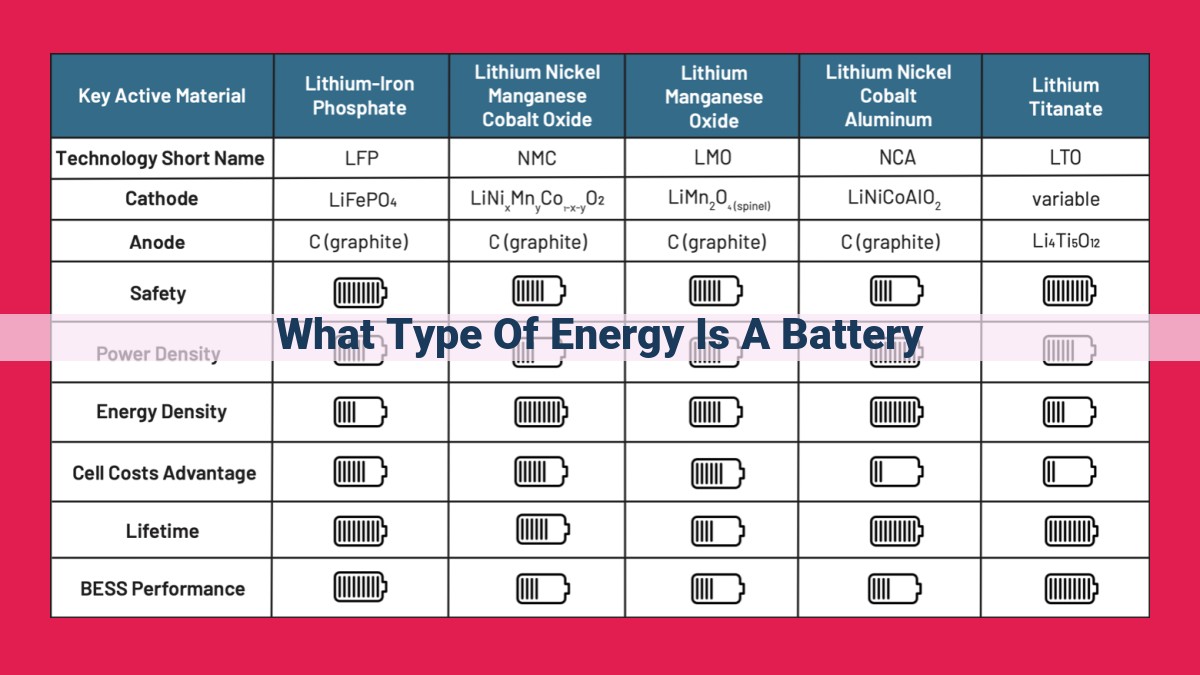Unlock The Energy Conversion Secrets: Batteries And Electrochemical Cells Explained

A battery stores chemical energy in its chemical bonds, which can be converted into electrical energy through electrochemical reactions. Electrochemical cells, like batteries, harness the conversion of chemical energy (enthalpy, bond energy, reduction-oxidation) to electrical energy (current, voltage, resistance, power). In these cells, the anode (negative electrode) undergoes oxidation (electron loss), while the cathode (positive electrode) undergoes reduction (electron gain). Batteries leverage these chemical and electrical energy transformations to power various devices.
Battery Energy Types
- Explain the different types of energy stored in a battery, including chemical energy (bond energy, enthalpy, oxidation-reduction) and electrical energy (current, voltage, resistance, power).
Battery Energy Types: Unlocking the Secrets of Power
Batteries are ubiquitous in our modern world, powering everything from smartphones to electric vehicles. But what exactly powers these devices? The answer lies in the different types of energy stored within a battery.
Chemical Energy: The Engine of Batteries
At the heart of a battery lies chemical energy, which is the energy stored within the chemical bonds of its materials. When a battery is in use, oxidation-reduction reactions take place, converting chemical energy into electrical energy. During oxidation, electrons are released, while during reduction, electrons are gained. These reactions create an electrical current, which flows through external circuits to power devices.
Electrical Energy: The Flow of Electrons
Electrical energy is the flow of electrons through a conductor. Within a battery, this flow is generated by the chemical reactions taking place. Voltage measures the electrical potential difference between the terminals of a battery, while current measures the rate of electron flow. Resistance is the opposition to the flow of electrons, and power is the rate at which electrical energy is transferred.
Understanding the different types of energy stored in a battery is crucial for comprehending their behavior and maximizing their performance. Whether it’s the chemical energy driving electrochemical reactions or the electrical energy flowing through external circuits, these concepts are essential to unraveling the secrets of battery power.
Electrochemical Cells: Transforming Energy through Chemical Reactions
Imagine a tiny power plant hidden within our everyday devices – that’s the world of electrochemical cells. These ingenious devices harness the power of chemical reactions to generate electricity or convert it back into chemical energy.
At the heart of an electrochemical cell lies a galvanic cell, where spontaneous chemical reactions drive electrical energy production. Like tiny generators, galvanic cells release electrons during these reactions, creating an electrical current that flows through an external circuit.
Voltaic cells, on the other hand, perform the opposite trick. They utilize an external voltage to force non-spontaneous chemical reactions. By supplying energy, voltaic cells can store electricity as chemical energy in a battery.
The final player in the electrochemical family is the fuel cell. Unlike batteries, fuel cells continuously consume fuel, such as hydrogen, to produce electricity. This makes them an ideal power source for applications where long-lasting energy is crucial.
Each electrochemical cell has two electrodes: the anode and the cathode. The anode is the negative electrode, attracting positively charged ions (cations). During a reaction, it undergoes oxidation, releasing electrons. The cathode, as the positive electrode, attracts negatively charged ions (anions) and undergoes reduction, gaining electrons.
These controlled chemical reactions within electrochemical cells provide the foundation for batteries, fuel cells, and many other energy-transforming devices. They are the unsung heroes of our electronic gadgets, powering our lives with efficient and portable energy solutions.
Understanding the Anode and Cathode: The Heart of Electrochemistry
In the realm of electrochemistry, batteries play a pivotal role in storing and releasing electrical energy. At the heart of these batteries are two crucial electrodes known as the anode and the cathode. These electrodes work in concert to facilitate the intricate dance of chemical reactions that produce electricity.
The Anode: A Loss and a Gain
The anode, the negative electrode, serves as the birthplace of oxidation, a process where atoms or molecules shed electrons. Driven by an attraction to positively charged cations, the anode becomes a haven for these ions, resulting in their loss of electrons. This loss marks the beginning of a journey that leads to the generation of electrical current.
The Cathode: A Welcome and a Reunion
The cathode, the positive electrode, acts as a sanctuary for negatively charged anions. Here, reduction takes center stage, a process where atoms or molecules embrace electrons. These electrons, gracefully donated by the anode, reunite with molecules on the cathode’s surface, triggering the release of electrical current.
A Symphony of Electron Flow
The anode and cathode, working in harmony, create a circuit that allows electrons to flow. This flow, like a symphony of electrical impulses, generates current, a crucial component of electrical energy. The difference in electrical potential, or voltage, between these electrodes propels the electrons, driving them through the circuit and powering our devices.